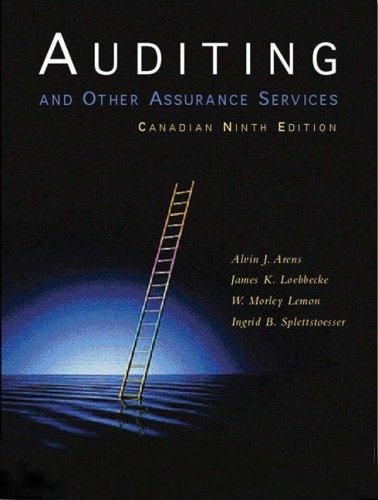Question
Three-Variance Method of Computing Overhead Variances The three-variance method collapses the variable and fixed overhead spending variances into a spending variance. It retains the efficiency
Three-Variance Method of Computing Overhead Variances
The three-variance method collapses the variable and fixed overhead spending variances into a spending variance. It retains the efficiency and volume variances from the four-variance method.
Spending variance = Actual overhead - (Budgeted fixed overhead + (Actual direct labor hours Standard variable overhead rate))
Example: Adler Company budgeted the following amounts at the beginning of the year:
| Units | 150,000 | ||
| Direct labor hours | 15,000 | ||
| Variable overhead | $30,000 | ||
| Fixed overhead | $69,000 |
At the end of the year, Adler provided the following actual data:
| Units | 140,000 | ||
| Direct labor hours | 14,300 | ||
| Variable overhead | $27,600 | ||
| Fixed overhead | $70,000 |
Spending variance = ($27,600 + $70,000) - [$69,000 + (14,300 $2)] = 0
Note that the spending variance is the sum of the variable overhead spending variance and the fixed overhead spending variance. For Adler Company, the variable overhead spending variance is $1,000 Favorable and the fixed overhead spending variance is $1,000 Unfavorable, so the overall spending variance is indeed zero.
Efficiency variance = [Budgeted fixed overhead + (Actual direct labor hours Standard variable overhead rate)] - [Budgeted fixed overhead + (Standard direct labor hours Standard variable overhead rate)]
Efficiency variance = [$69,000 + (14,300 $2)] - [$69,000 + (14,000 $2)] = $600 Unfavorable
Notice that the efficiency variance computed under the three-variance method is the variable overhead efficiency variance.
Volume variance = [Budgeted fixed overhead + (Standard direct labor hours Standard variable overhead rate)] - (Standard direct labor hours Overhead rate)
Volume variance = $97,000 - 92,400 = $4,600 Unfavorable
Notice that the volume variance computed under the three-variance method is the fixed overhead volume variance.
Two-Variance Method of Computing Overhead Variances
The two-variance method of computing overhead variances collapses the four-variance method into a budget variance and a volume variance. The volume variance is the volume variance computed in the four-variance method. The budget variance, then, must be the sum of the variance overhead spending variance, the variable overhead efficiency variance, and the fixed overhead spending variance.
Budget variance = Actual overhead - [Budgeted fixed overhead + (Standard hours Variable overhead rate)]

Options to Drop Down.
Equal to or Not Equal to
Example: Adler Company budgeted the following amounts at the beginning of the year: Units 150,000 Direct labor hours 15,000 Variable overhead $30,000 Fixed overhead $69,000 At the end of the year, Adler provided the following actual data: Units 140,000 Direct labor hours 14,300 Variable overhead $27,600 Fixed overhead $70,000 Spending variance = ($27,600 + $70,000) - [569,000 + (14,300 x $2)) = 0 Note that the spending variance is the sum of the variable overhead spending variance and the fixed overhead spending variance. For Adler Company, the variable overhead spending variance is $1,000 Favorable and the fixed overhead spending variance is $1,000 Unfavorable, so the overall spending variance is indeed zero. Efficiency variance = (Budgeted fixed overhead + (Actual direct labor hours x Standard variable overhead rate)] - [Budgeted fixed overhead + (Standard direct labor hours x Standard variable overhead rate)] Efficiency variance = ($69,000 + (14,300 x $2)] - [S69,000 + (14,000 x sz)] = $600 Unfavorable Notice that the efficiency variance computed under the three-variance method is the variable overhead efficiency variance. Volume variance = (Budgeted fixed overhead + (Standard direct labor hours x Standard variable overhead rate)] - (Standard direct labor hours x Overhead rate) Volume variance = $97,000 - 92,400 = $4,600 Unfavorable Notice that the volume variance computed under the three-variance method is the fixed overhead volume variance. Two-Variance Method of Computing Overhead Variances The two-variance method of computing overhead variances collapses the four-variance method into a budget variance and a volume variance. The volume variance is the volume variance computed in the four- variance method. The budget variance, then, must be the sum of the variance overhead spending variance, the variable overhead efficiency variance, and the fixed overhead spending variance. Budget variance = Actual overhead - [Budgeted fixed overhead + (Standard hours x Variable overhead rate)]Step by Step Solution
There are 3 Steps involved in it
Step: 1

Get Instant Access to Expert-Tailored Solutions
See step-by-step solutions with expert insights and AI powered tools for academic success
Step: 2

Step: 3

Ace Your Homework with AI
Get the answers you need in no time with our AI-driven, step-by-step assistance
Get Started


